seats FORD GT 2018 Owners Manual
[x] Cancel search | Manufacturer: FORD, Model Year: 2018, Model line: GT, Model: FORD GT 2018Pages: 325, PDF Size: 6.61 MB
Page 4 of 325
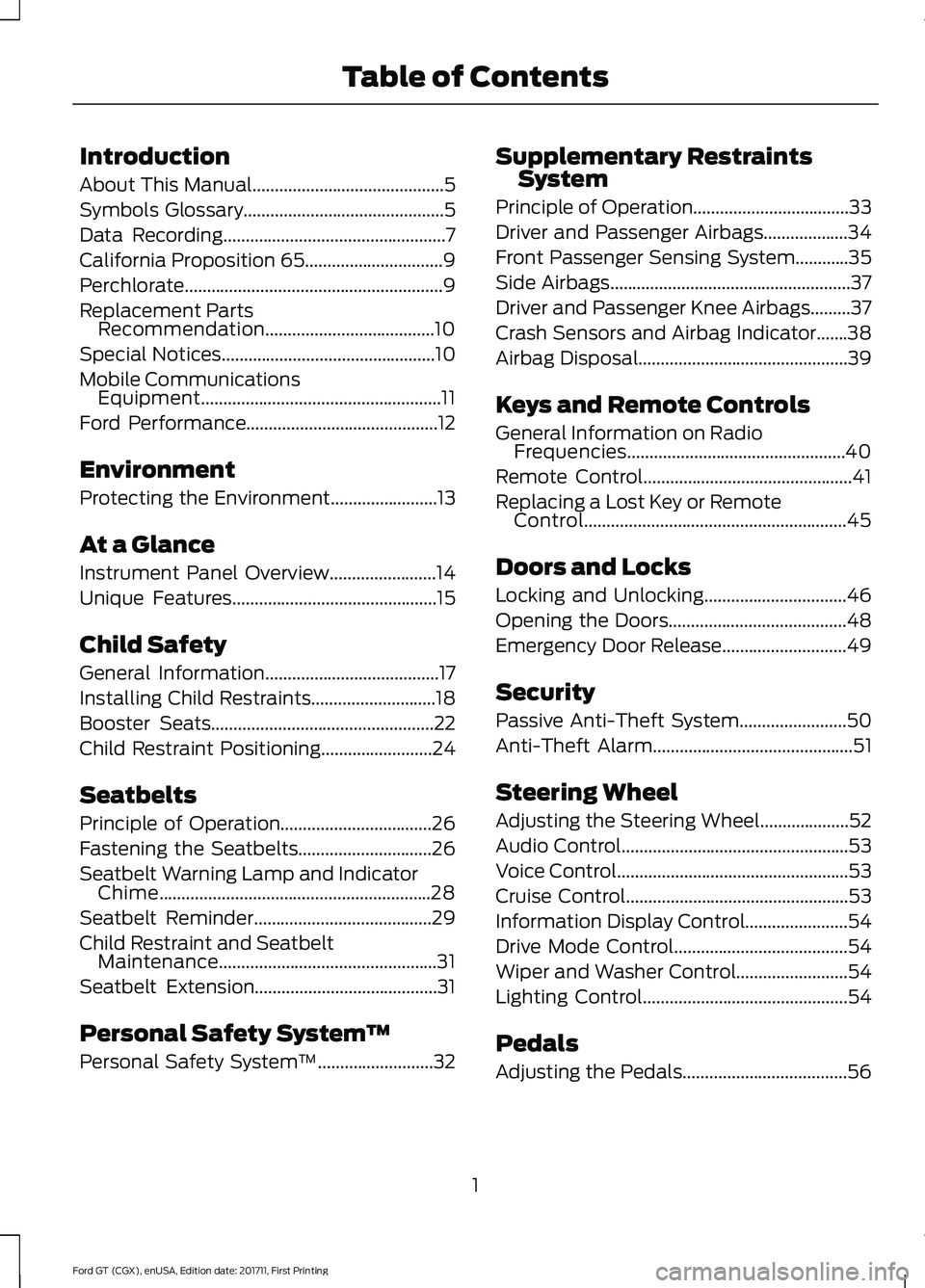
Introduction
About This Manual...........................................5
Symbols Glossary.............................................5
Data Recording..................................................7
California Proposition 65...............................9
Perchlorate..........................................................9
Replacement Parts Recommendation......................................10
Special Notices
................................................10
Mobile Communications Equipment......................................................11
Ford Performance...........................................12
Environment
Protecting the Environment
........................13
At a Glance
Instrument Panel Overview
........................14
Unique Features
..............................................15
Child Safety
General Information.......................................17
Installing Child Restraints
............................18
Booster Seats
..................................................22
Child Restraint Positioning.........................24
Seatbelts
Principle of Operation..................................26
Fastening the Seatbelts..............................26
Seatbelt Warning Lamp and Indicator Chime.............................................................28
Seatbelt Reminder
........................................29
Child Restraint and Seatbelt Maintenance
.................................................31
Seatbelt Extension.........................................31
Personal Safety System ™
Personal Safety System ™
..........................32Supplementary Restraints
System
Principle of Operation...................................33
Driver and Passenger Airbags...................34
Front Passenger Sensing System............35
Side Airbags......................................................37
Driver and Passenger Knee Airbags.........37
Crash Sensors and Airbag Indicator.......38
Airbag Disposal...............................................39
Keys and Remote Controls
General Information on Radio Frequencies.................................................40
Remote Control...............................................41
Replacing a Lost Key or Remote Control...........................................................45
Doors and Locks
Locking and Unlocking
................................46
Opening the Doors........................................48
Emergency Door Release............................49
Security
Passive Anti-Theft System
........................50
Anti-Theft Alarm
.............................................51
Steering Wheel
Adjusting the Steering Wheel
....................52
Audio Control
...................................................53
Voice Control....................................................53
Cruise Control
..................................................53
Information Display Control.......................54
Drive Mode Control.......................................54
Wiper and Washer Control.........................54
Lighting Control
..............................................54
Pedals
Adjusting the Pedals.....................................56
1
Ford GT (CGX), enUSA, Edition date: 201711, First Printing Table of Contents
Page 5 of 325
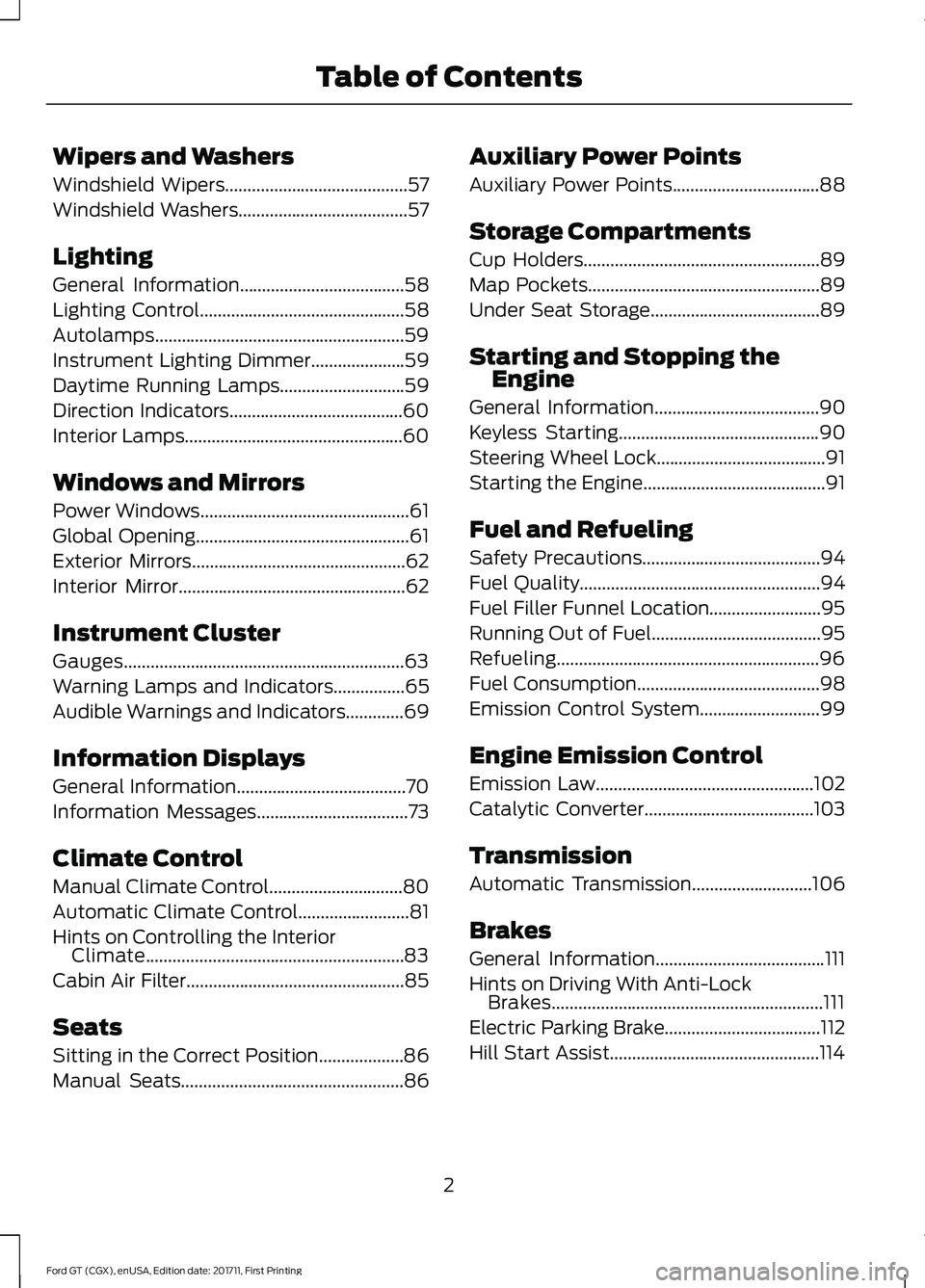
Wipers and Washers
Windshield Wipers.........................................57
Windshield Washers......................................57
Lighting
General Information
.....................................58
Lighting Control
..............................................58
Autolamps........................................................59
Instrument Lighting Dimmer.....................59
Daytime Running Lamps............................59
Direction Indicators
.......................................60
Interior Lamps
.................................................60
Windows and Mirrors
Power Windows...............................................61
Global Opening................................................61
Exterior Mirrors
................................................62
Interior Mirror
...................................................62
Instrument Cluster
Gauges...............................................................63
Warning Lamps and Indicators
................65
Audible Warnings and Indicators.............69
Information Displays
General Information......................................70
Information Messages
..................................73
Climate Control
Manual Climate Control
..............................80
Automatic Climate Control
.........................81
Hints on Controlling the Interior Climate..........................................................83
Cabin Air Filter.................................................85
Seats
Sitting in the Correct Position...................86
Manual Seats
..................................................86 Auxiliary Power Points
Auxiliary Power Points.................................88
Storage Compartments
Cup Holders.....................................................89
Map Pockets
....................................................89
Under Seat Storage......................................89
Starting and Stopping the Engine
General Information
.....................................90
Keyless Starting
.............................................90
Steering Wheel Lock......................................91
Starting the Engine.........................................91
Fuel and Refueling
Safety Precautions
........................................94
Fuel Quality
......................................................94
Fuel Filler Funnel Location.........................95
Running Out of Fuel......................................95
Refueling...........................................................96
Fuel Consumption.........................................98
Emission Control System...........................99
Engine Emission Control
Emission Law
.................................................102
Catalytic Converter
......................................103
Transmission
Automatic Transmission
...........................106
Brakes
General Information
......................................111
Hints on Driving With Anti-Lock Brakes.............................................................111
Electric Parking Brake
...................................112
Hill Start Assist...............................................114
2
Ford GT (CGX), enUSA, Edition date: 201711, First Printing Table of Contents
Page 7 of 325
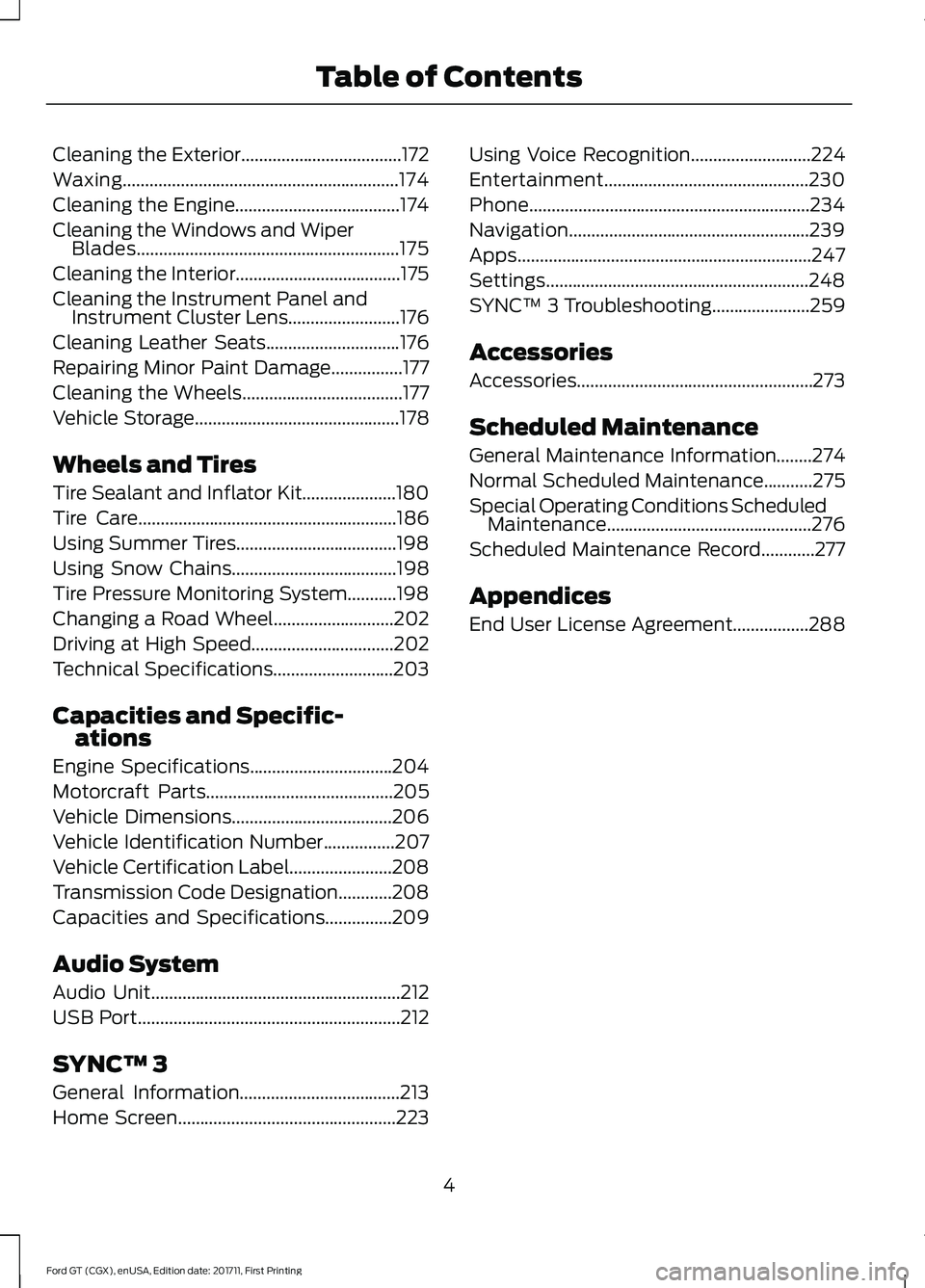
Cleaning the Exterior....................................172
Waxing..............................................................174
Cleaning the Engine.....................................174
Cleaning the Windows and Wiper
Blades...........................................................175
Cleaning the Interior.....................................175
Cleaning the Instrument Panel and Instrument Cluster Lens.........................176
Cleaning Leather Seats
..............................176
Repairing Minor Paint Damage
................177
Cleaning the Wheels
....................................177
Vehicle Storage
..............................................178
Wheels and Tires
Tire Sealant and Inflator Kit.....................180
Tire Care
..........................................................186
Using Summer Tires....................................198
Using Snow Chains
.....................................198
Tire Pressure Monitoring System...........198
Changing a Road Wheel
...........................202
Driving at High Speed................................202
Technical Specifications
...........................203
Capacities and Specific- ations
Engine Specifications................................204
Motorcraft Parts
..........................................205
Vehicle Dimensions
....................................206
Vehicle Identification Number
................207
Vehicle Certification Label.......................208
Transmission Code Designation............208
Capacities and Specifications...............209
Audio System
Audio Unit
........................................................212
USB Port...........................................................212
SYNC™ 3
General Information
....................................213
Home Screen.................................................223 Using Voice Recognition
...........................224
Entertainment..............................................230
Phone...............................................................234
Navigation......................................................239
Apps
..................................................................247
Settings...........................................................248
SYNC™ 3 Troubleshooting......................259
Accessories
Accessories.....................................................273
Scheduled Maintenance
General Maintenance Information
........274
Normal Scheduled Maintenance
...........275
Special Operating Conditions Scheduled Maintenance..............................................276
Scheduled Maintenance Record
............277
Appendices
End User License Agreement.................288
4
Ford GT (CGX), enUSA, Edition date: 201711, First Printing Table of Contents
Page 8 of 325
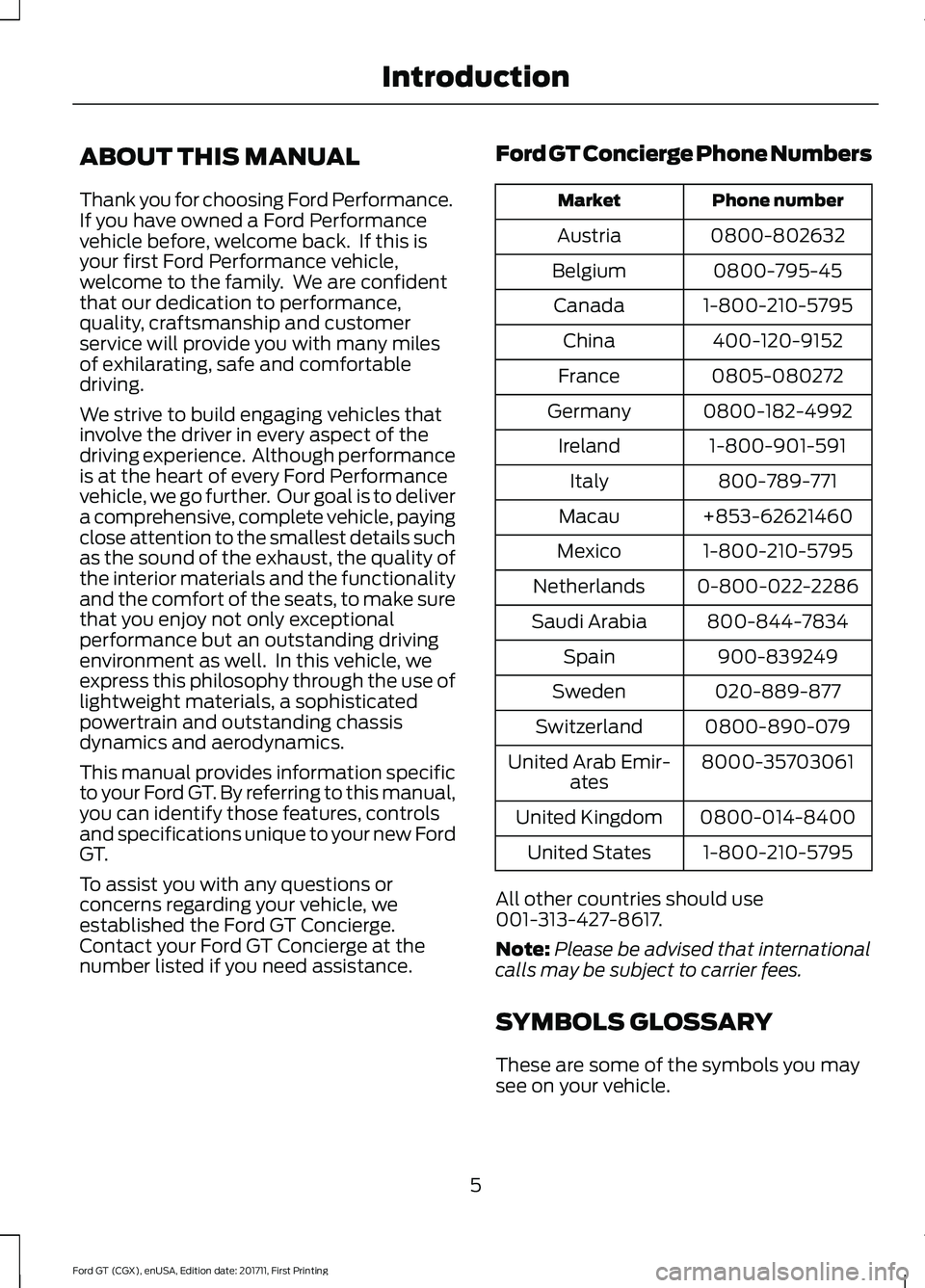
ABOUT THIS MANUAL
Thank you for choosing Ford Performance.
If you have owned a Ford Performance
vehicle before, welcome back. If this is
your first Ford Performance vehicle,
welcome to the family. We are confident
that our dedication to performance,
quality, craftsmanship and customer
service will provide you with many miles
of exhilarating, safe and comfortable
driving.
We strive to build engaging vehicles that
involve the driver in every aspect of the
driving experience. Although performance
is at the heart of every Ford Performance
vehicle, we go further. Our goal is to deliver
a comprehensive, complete vehicle, paying
close attention to the smallest details such
as the sound of the exhaust, the quality of
the interior materials and the functionality
and the comfort of the seats, to make sure
that you enjoy not only exceptional
performance but an outstanding driving
environment as well. In this vehicle, we
express this philosophy through the use of
lightweight materials, a sophisticated
powertrain and outstanding chassis
dynamics and aerodynamics.
This manual provides information specific
to your Ford GT. By referring to this manual,
you can identify those features, controls
and specifications unique to your new Ford
GT.
To assist you with any questions or
concerns regarding your vehicle, we
established the Ford GT Concierge.
Contact your Ford GT Concierge at the
number listed if you need assistance.
Ford GT Concierge Phone Numbers Phone number
Market
0800-802632
Austria
0800-795-45
Belgium
1-800-210-5795
Canada
400-120-9152
China
0805-080272
France
0800-182-4992
Germany
1-800-901-591
Ireland
800-789-771
Italy
+853-62621460
Macau
1-800-210-5795
Mexico
0-800-022-2286
Netherlands
800-844-7834
Saudi Arabia
900-839249
Spain
020-889-877
Sweden
0800-890-079
Switzerland
8000-35703061
United Arab Emir-
ates
0800-014-8400
United Kingdom
1-800-210-5795
United States
All other countries should use
001-313-427-8617.
Note: Please be advised that international
calls may be subject to carrier fees.
SYMBOLS GLOSSARY
These are some of the symbols you may
see on your vehicle.
5
Ford GT (CGX), enUSA, Edition date: 201711, First Printing Introduction
Page 20 of 325

GENERAL INFORMATION
See the following sections for directions
on how to properly use safety restraints
for children.
WARNINGS
Always make sure your child is
secured properly in a device that is
appropriate for their height, age and
weight. Child safety restraints must be
bought separately from your vehicle.
Failure to follow these instructions and
guidelines may result in an increased risk
of serious injury or death to your child. All children are shaped differently.
The recommendations for safety
restraints are based on probable
child height, age and weight thresholds
from the National Highway Traffic Safety
Administration and other safety
organizations, or are the minimum
requirements of law. We recommend
checking with a NHTSA Certified Child WARNINGS
Passenger Safety Technician (CPST) and
consult your pediatrician to make sure your
child seat is appropriate for your child, and
is compatible with and properly installed
in your vehicle. To locate a child seat fitting
station and CPST, contact NHTSA toll free
at 1-888-327-4236 or go to
http://www.nhtsa.dot.gov. In Canada,
contact Transport Canada toll free at
1-800-333-0371 or go to www.tc.gc.ca to
find a Child Car Seat Clinic in your area.
Failure to properly restrain children in
safety seats made especially for their
height, age, and weight may result in an
increased risk of serious injury or death to
your child. On hot days, the temperature inside
the vehicle can rise very quickly.
Exposure of people or animals to
these high temperatures for even a short
time can cause death or serious heat
related injuries, including brain damage.
Small children are particularly at risk. 17
Ford GT (CGX), enUSA, Edition date: 201711, First Printing Child Safety
Page 21 of 325
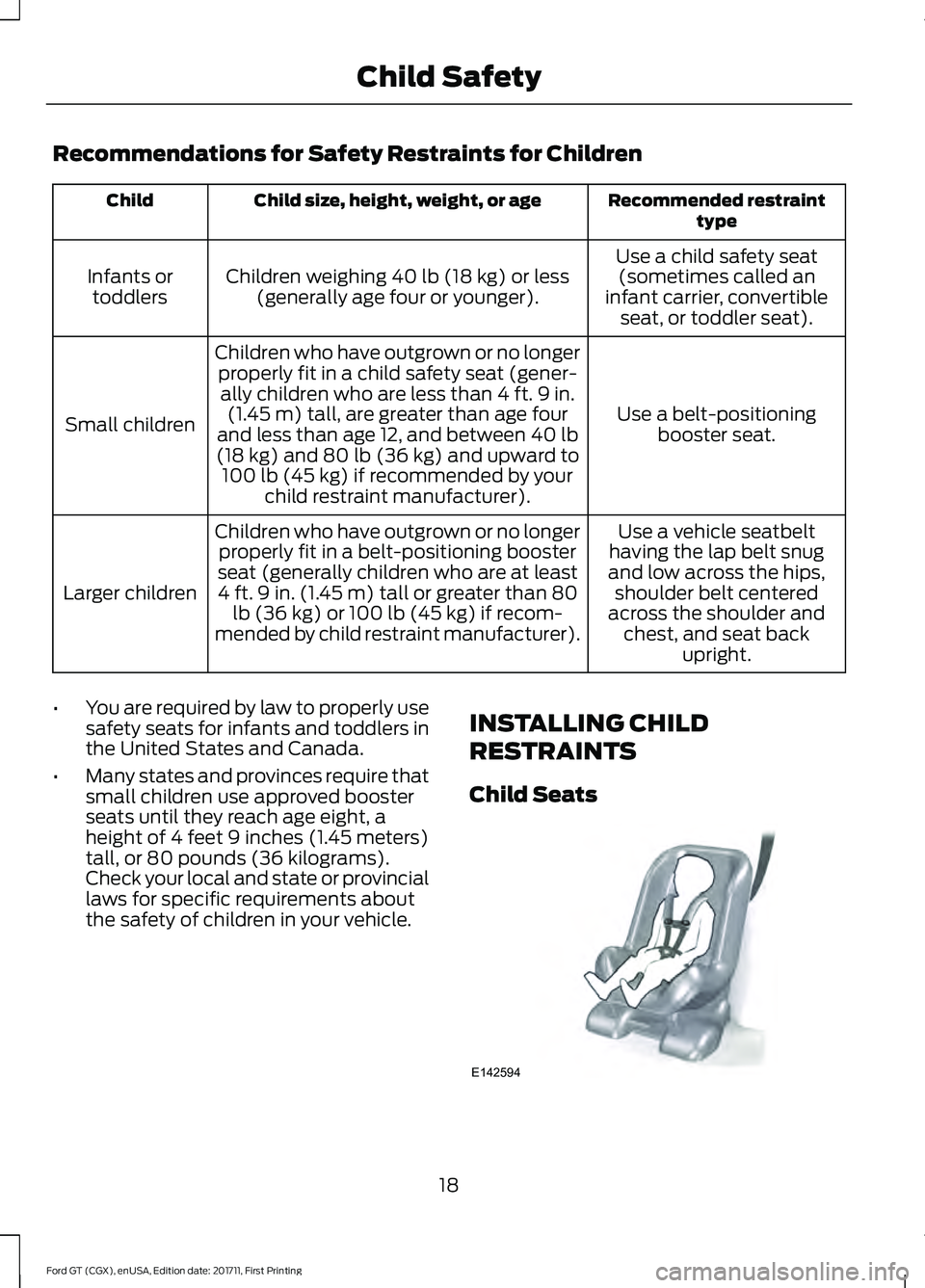
Recommendations for Safety Restraints for Children
Recommended restraint
type
Child size, height, weight, or age
Child
Use a child safety seat(sometimes called an
infant carrier, convertible seat, or toddler seat).
Children weighing 40 lb (18 kg) or less
(generally age four or younger).
Infants or
toddlers
Use a belt-positioningbooster seat.
Children who have outgrown or no longer
properly fit in a child safety seat (gener-ally children who are less than 4 ft. 9 in. (1.45 m) tall, are greater than age four
and less than age 12, and between 40 lb
(18 kg) and 80 lb (36 kg) and upward to 100 lb (45 kg) if recommended by your child restraint manufacturer).
Small children
Use a vehicle seatbelt
having the lap belt snug
and low across the hips, shoulder belt centered
across the shoulder and chest, and seat back upright.
Children who have outgrown or no longer
properly fit in a belt-positioning booster
seat (generally children who are at least
4 ft. 9 in. (1.45 m) tall or greater than 80 lb (36 kg) or 100 lb (45 kg) if recom-
mended by child restraint manufacturer).
Larger children
• You are required by law to properly use
safety seats for infants and toddlers in
the United States and Canada.
• Many states and provinces require that
small children use approved booster
seats until they reach age eight, a
height of 4 feet 9 inches (1.45 meters)
tall, or 80 pounds (36 kilograms).
Check your local and state or provincial
laws for specific requirements about
the safety of children in your vehicle. INSTALLING CHILD
RESTRAINTS
Child Seats
18
Ford GT (CGX), enUSA, Edition date: 201711, First Printing Child SafetyE142594
Page 24 of 325
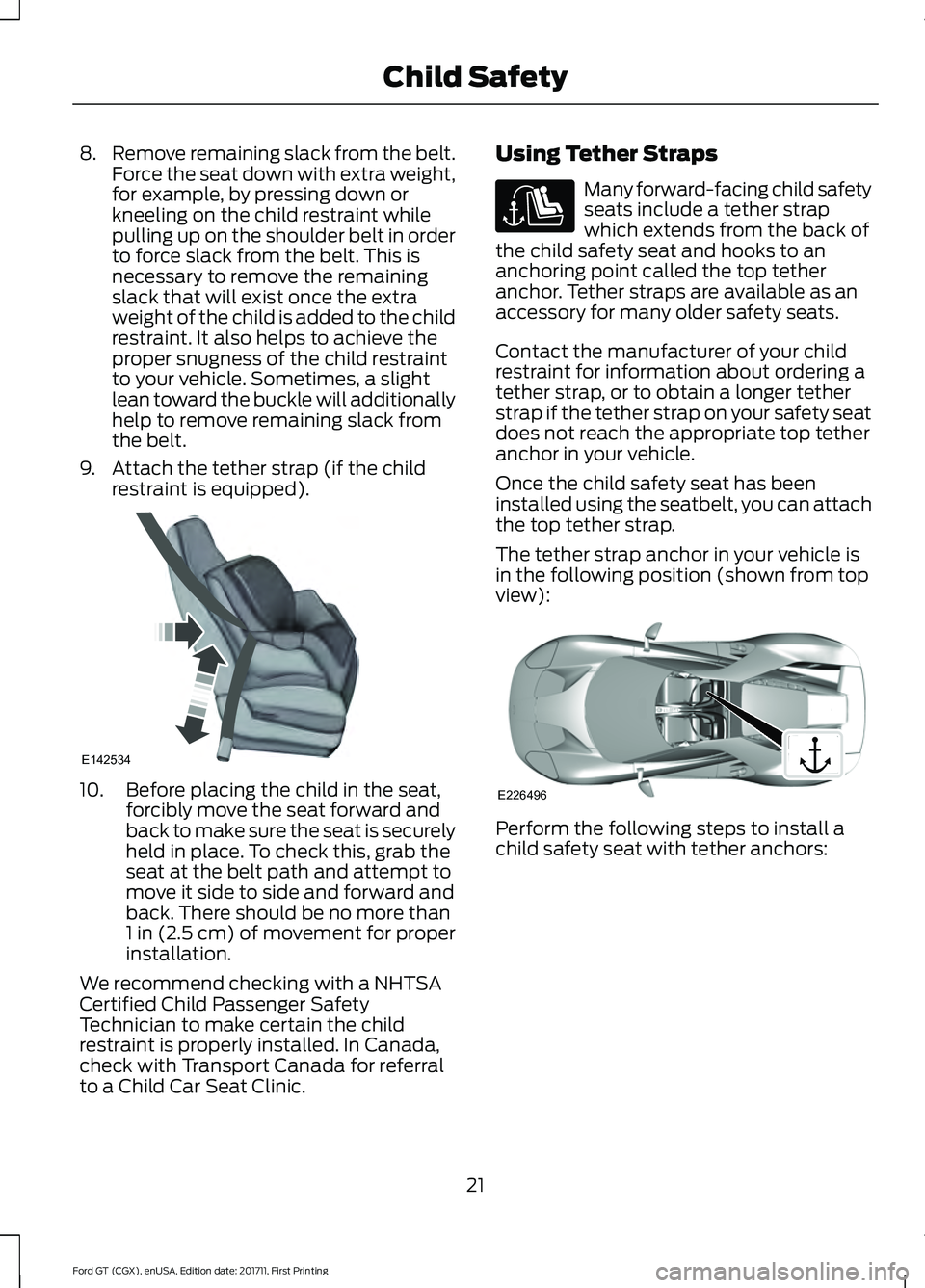
8.
Remove remaining slack from the belt.
Force the seat down with extra weight,
for example, by pressing down or
kneeling on the child restraint while
pulling up on the shoulder belt in order
to force slack from the belt. This is
necessary to remove the remaining
slack that will exist once the extra
weight of the child is added to the child
restraint. It also helps to achieve the
proper snugness of the child restraint
to your vehicle. Sometimes, a slight
lean toward the buckle will additionally
help to remove remaining slack from
the belt.
9. Attach the tether strap (if the child restraint is equipped). 10. Before placing the child in the seat,
forcibly move the seat forward and
back to make sure the seat is securely
held in place. To check this, grab the
seat at the belt path and attempt to
move it side to side and forward and
back. There should be no more than
1 in (2.5 cm) of movement for proper
installation.
We recommend checking with a NHTSA
Certified Child Passenger Safety
Technician to make certain the child
restraint is properly installed. In Canada,
check with Transport Canada for referral
to a Child Car Seat Clinic. Using Tether Straps Many forward-facing child safety
seats include a tether strap
which extends from the back of
the child safety seat and hooks to an
anchoring point called the top tether
anchor. Tether straps are available as an
accessory for many older safety seats.
Contact the manufacturer of your child
restraint for information about ordering a
tether strap, or to obtain a longer tether
strap if the tether strap on your safety seat
does not reach the appropriate top tether
anchor in your vehicle.
Once the child safety seat has been
installed using the seatbelt, you can attach
the top tether strap.
The tether strap anchor in your vehicle is
in the following position (shown from top
view): Perform the following steps to install a
child safety seat with tether anchors:
21
Ford GT (CGX), enUSA, Edition date: 201711, First Printing Child SafetyE142534 E226496
Page 25 of 325
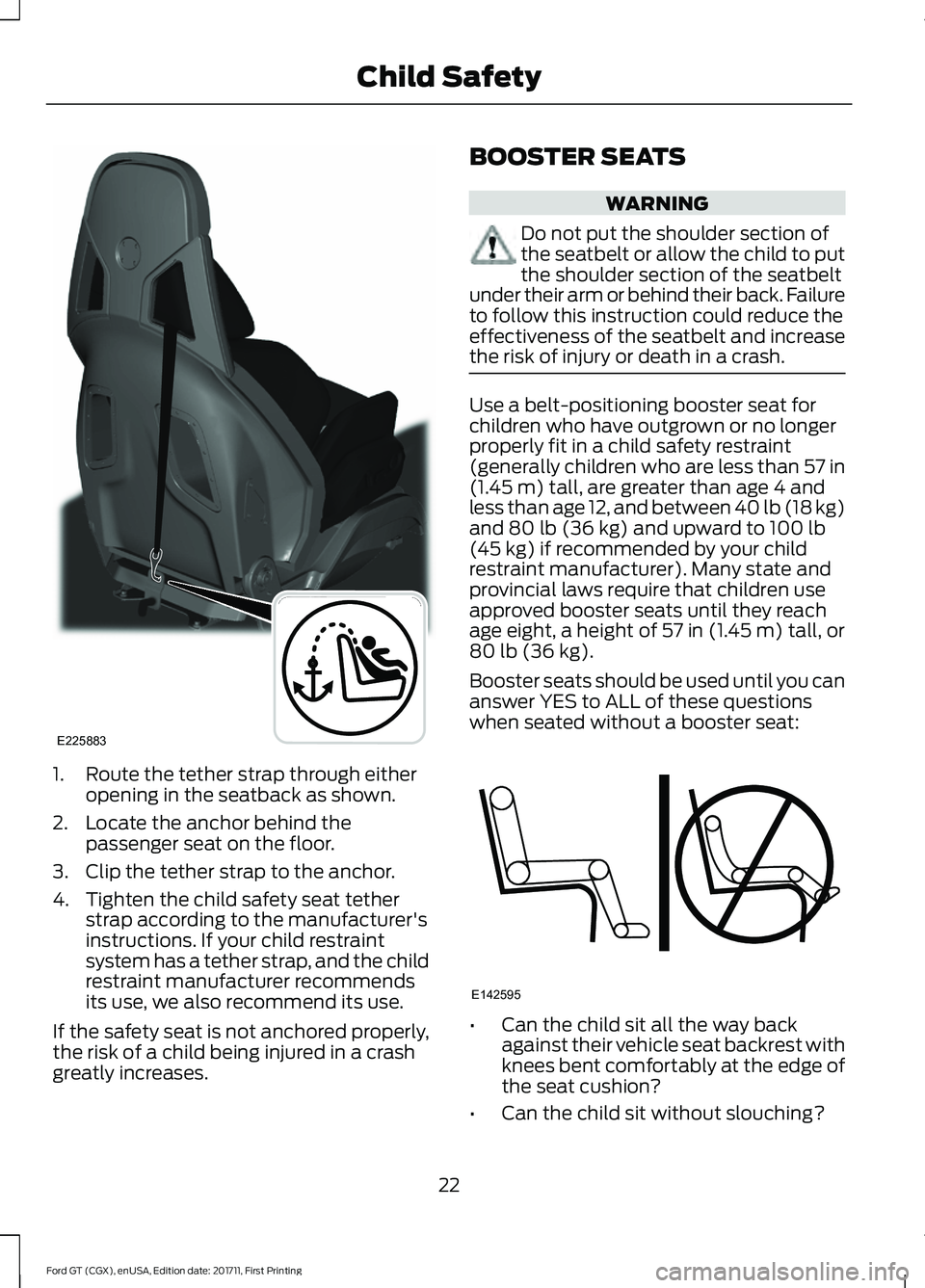
1. Route the tether strap through either
opening in the seatback as shown.
2. Locate the anchor behind the passenger seat on the floor.
3. Clip the tether strap to the anchor.
4. Tighten the child safety seat tether strap according to the manufacturer's
instructions. If your child restraint
system has a tether strap, and the child
restraint manufacturer recommends
its use, we also recommend its use.
If the safety seat is not anchored properly,
the risk of a child being injured in a crash
greatly increases. BOOSTER SEATS WARNING
Do not put the shoulder section of
the seatbelt or allow the child to put
the shoulder section of the seatbelt
under their arm or behind their back. Failure
to follow this instruction could reduce the
effectiveness of the seatbelt and increase
the risk of injury or death in a crash. Use a belt-positioning booster seat for
children who have outgrown or no longer
properly fit in a child safety restraint
(generally children who are less than 57 in
(1.45 m) tall, are greater than age 4 and
less than age 12, and between 40 lb (18 kg)
and
80 lb (36 kg) and upward to 100 lb
(45 kg) if recommended by your child
restraint manufacturer). Many state and
provincial laws require that children use
approved booster seats until they reach
age eight, a height of
57 in (1.45 m) tall, or
80 lb (36 kg).
Booster seats should be used until you can
answer YES to ALL of these questions
when seated without a booster seat: •
Can the child sit all the way back
against their vehicle seat backrest with
knees bent comfortably at the edge of
the seat cushion?
• Can the child sit without slouching?
22
Ford GT (CGX), enUSA, Edition date: 201711, First Printing Child SafetyE225883 E142595
Page 26 of 325
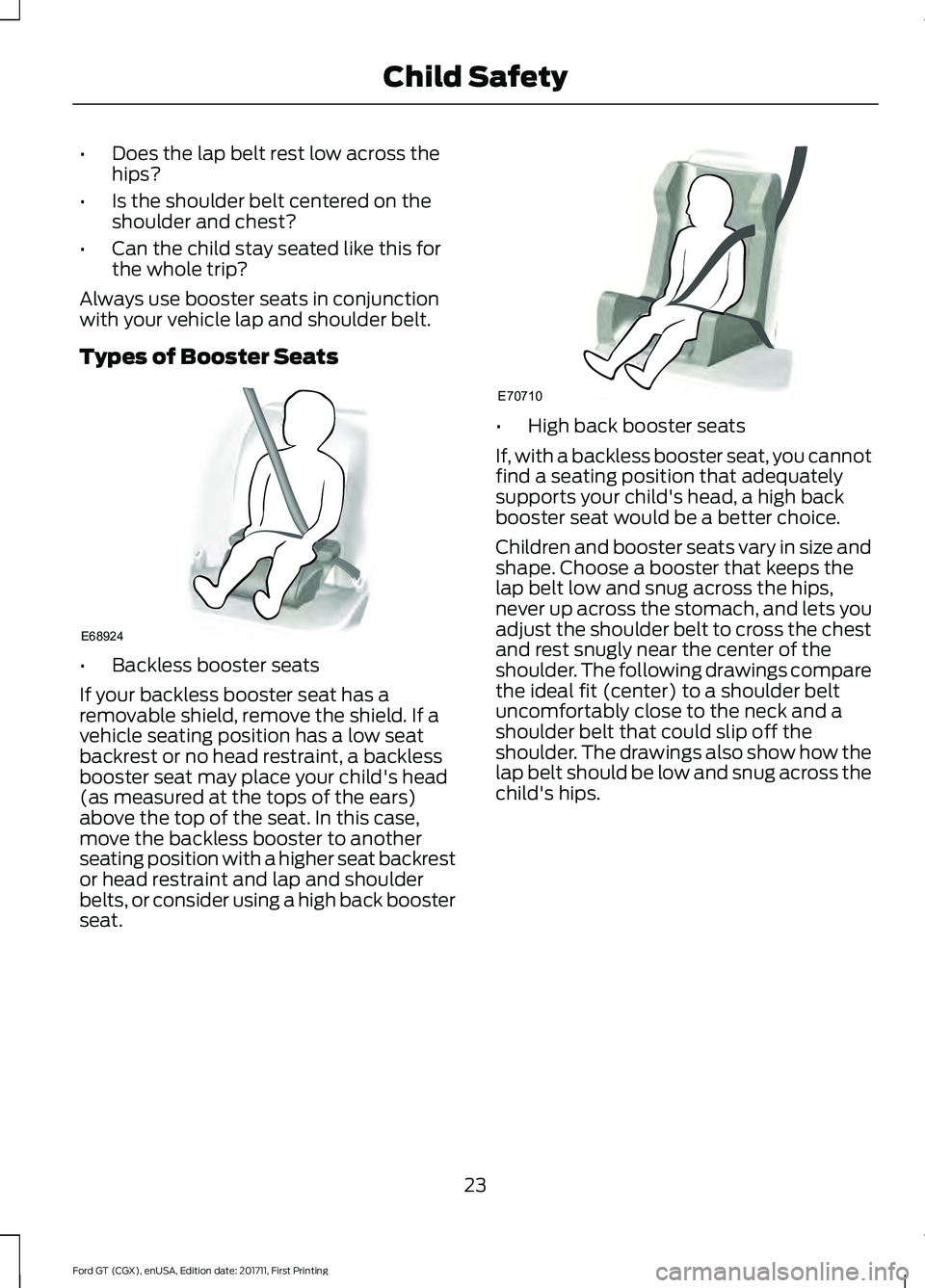
•
Does the lap belt rest low across the
hips?
• Is the shoulder belt centered on the
shoulder and chest?
• Can the child stay seated like this for
the whole trip?
Always use booster seats in conjunction
with your vehicle lap and shoulder belt.
Types of Booster Seats •
Backless booster seats
If your backless booster seat has a
removable shield, remove the shield. If a
vehicle seating position has a low seat
backrest or no head restraint, a backless
booster seat may place your child's head
(as measured at the tops of the ears)
above the top of the seat. In this case,
move the backless booster to another
seating position with a higher seat backrest
or head restraint and lap and shoulder
belts, or consider using a high back booster
seat. •
High back booster seats
If, with a backless booster seat, you cannot
find a seating position that adequately
supports your child's head, a high back
booster seat would be a better choice.
Children and booster seats vary in size and
shape. Choose a booster that keeps the
lap belt low and snug across the hips,
never up across the stomach, and lets you
adjust the shoulder belt to cross the chest
and rest snugly near the center of the
shoulder. The following drawings compare
the ideal fit (center) to a shoulder belt
uncomfortably close to the neck and a
shoulder belt that could slip off the
shoulder. The drawings also show how the
lap belt should be low and snug across the
child's hips.
23
Ford GT (CGX), enUSA, Edition date: 201711, First Printing Child SafetyE68924 E70710
Page 29 of 325
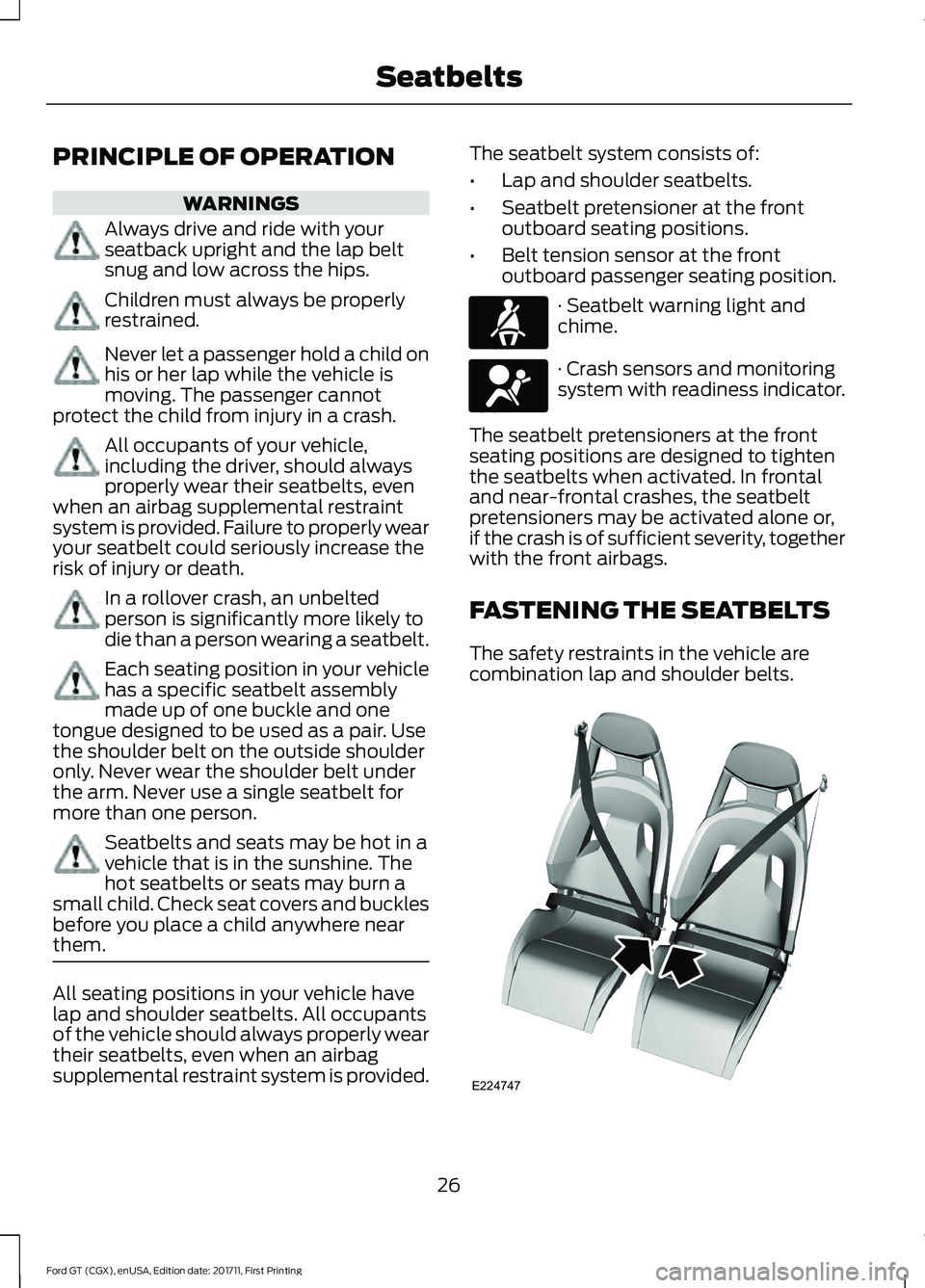
PRINCIPLE OF OPERATION
WARNINGS
Always drive and ride with your
seatback upright and the lap belt
snug and low across the hips.
Children must always be properly
restrained.
Never let a passenger hold a child on
his or her lap while the vehicle is
moving. The passenger cannot
protect the child from injury in a crash. All occupants of your vehicle,
including the driver, should always
properly wear their seatbelts, even
when an airbag supplemental restraint
system is provided. Failure to properly wear
your seatbelt could seriously increase the
risk of injury or death. In a rollover crash, an unbelted
person is significantly more likely to
die than a person wearing a seatbelt.
Each seating position in your vehicle
has a specific seatbelt assembly
made up of one buckle and one
tongue designed to be used as a pair. Use
the shoulder belt on the outside shoulder
only. Never wear the shoulder belt under
the arm. Never use a single seatbelt for
more than one person. Seatbelts and seats may be hot in a
vehicle that is in the sunshine. The
hot seatbelts or seats may burn a
small child. Check seat covers and buckles
before you place a child anywhere near
them. All seating positions in your vehicle have
lap and shoulder seatbelts. All occupants
of the vehicle should always properly wear
their seatbelts, even when an airbag
supplemental restraint system is provided. The seatbelt system consists of:
•
Lap and shoulder seatbelts.
• Seatbelt pretensioner at the front
outboard seating positions.
• Belt tension sensor at the front
outboard passenger seating position. · Seatbelt warning light and
chime.
· Crash sensors and monitoring
system with readiness indicator.
The seatbelt pretensioners at the front
seating positions are designed to tighten
the seatbelts when activated. In frontal
and near-frontal crashes, the seatbelt
pretensioners may be activated alone or,
if the crash is of sufficient severity, together
with the front airbags.
FASTENING THE SEATBELTS
The safety restraints in the vehicle are
combination lap and shoulder belts. 26
Ford GT (CGX), enUSA, Edition date: 201711, First Printing SeatbeltsE71880 E67017 E224747